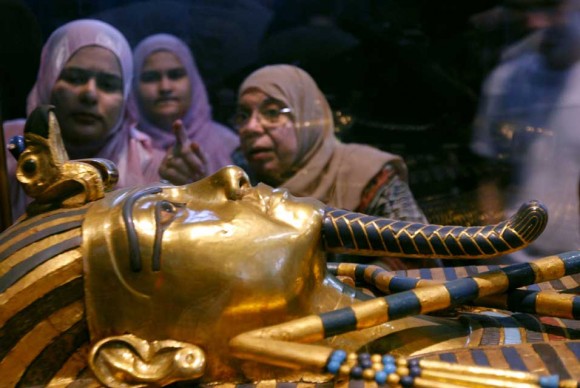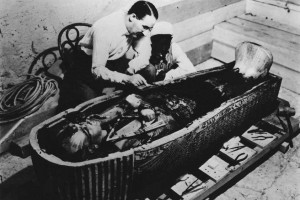Tests Show King Tutankhamen Died from Malaria Infection, Study Says
February 17, 2010 by All Art News
Filed under Antiques & Archaeology, Featured
CHICAGO.- King Tutankhamen, the teen-aged pharaoh whose Egyptian tomb yielded dazzling treasures, limped around on tender bones and a club foot and probably died from malaria, researchers said on Tuesday.
There has been speculation about the fate of the boy king, who died sometime around 1324 BC probably at age 19, since the 1922 discovery of his intact tomb in Egypt’s Valley of Kings.

- Women look at one of the coffins of King Tutankhamun at the Egyptian museum in Cairo, Egypt. Egypt’s famed King Tutankhamun suffered from a cleft palate and club foot, likely forcing him to walk with a cane, and died from complications from a broken leg exacerbated by malaria, according to the most extensive study ever of his mummy
Tests performed on 16 royal mummies found four, including Tut, had contracted a severe form of malaria that likely cut short Tut’s reign — ruling out murder or some other sickness.
Scientists from Egypt, Germany and elsewhere, including Zahi Hawass of Egypt’s Supreme Council of Antiquities, compiled results from genetic and radiological testing performed on the mummies between 2007 and 2009. The results clarify details about the 155-year-long 18th Dynasty that included Tutankhamen, who inherited the throne at age 11.
The scientists speculated Tut was weakened by a broken leg possibly from a fall. That and a malaria infection led to his death, they believe.
Tut was afflicted with a cleft palate, mild clubfoot in his left foot and other bone ailments. He and some family members had a form of Kohler disease, which can cause foot bones to collapse from lack of blood but would not have been fatal.
“Tutankhamen had multiple disorders, and some of them might have reached the cumulative character of an inflammatory, immune-suppressive — and thus weakening — syndrome. He might be envisioned as a young but frail king who needed canes to walk,” Hawass wrote in the Journal of the American Medical Association.
Besides the priceless gold artifacts found in Tut’s tomb, he was also equipped for the afterlife with some 130 canes and staves — some with signs of wear — and a veritable pharmacy.
The scientists were also fairly certain they identified the mummies belonging to Tut’s father, Akhenaten, and his grandmother, Tiye, based on shared blood groups.
They shot down speculation that Tut and his forebears had severe abnormalities, ruling out Marfan syndrome and another condition that could have led to enlarged breasts.
“It is unlikely that either Tutankhamen or Akhenaten actually displayed a significantly bizarre or feminine physique. It is important to note that ancient Egyptian kings typically had themselves and their families represented in an idealized fashion,” Hawass wrote.
Related posts:
- MFA Houston to Present Tutankhamun: The Golden King and the Great Pharaohs in October 2011
- Egypt to Soon Announce King Tutankhamun DNA Test Results
- Exhibition in Minnesota Brings to Life the Discovery of King Tutankhamun’s Tomb
- Archaeologists in Egypt Find Ptolemaic-Era King Statue
- King Tutankhamun Returns to New York After More than 30 Years for Last Leg of U.S. Exhibit

